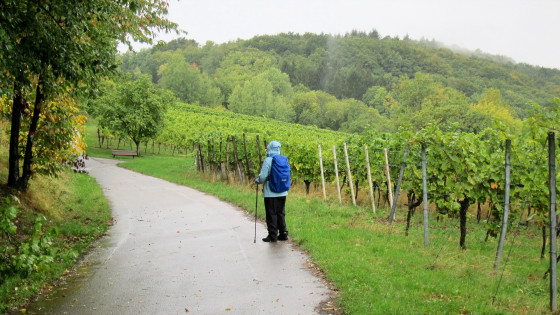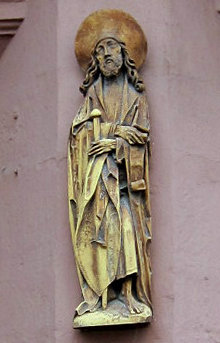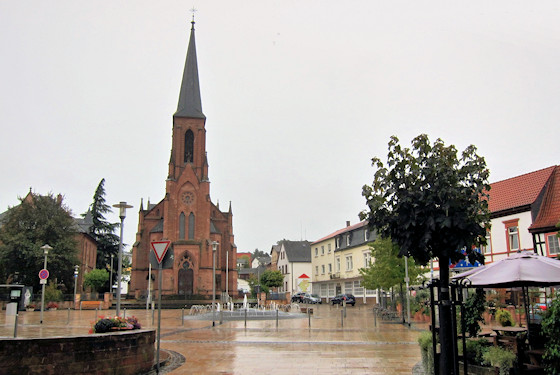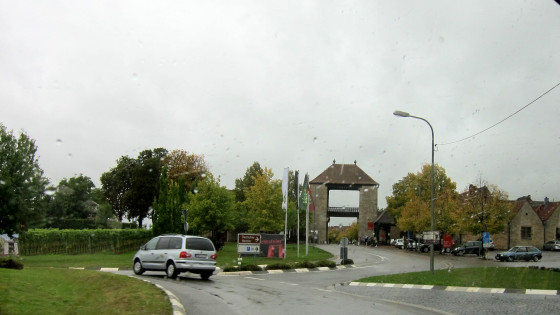At the hotel "Stiftsgut Keysermühle" we woke up in the morning well rested, but the steady drumming of the rain did not really invite us to continue. That was the rainy day. Continuous rain was forecast from early to late, a test for the rain gear.
The rain doesn't bother me that much when I'm hiking. Only the area looks much friendlier in the sunshine and today we have a nice stage on the programme.

When we leave our pilgrim hostel, the Hotel Stiftsgut Keysermühle, it is raining.

We are heading out of Klingenmünster. Landeck Castle towers above us.

In the forest, the path goes steeply uphill over many stone steps. At the top, Klingenmünster lies before us. Use the sun button to conjure up some sunshine in the picture.

We approach the next wine village Gleiszellen-Gleishorbach with the church St. Dionysius on the hill.

We walk through Gleiszellen.

On this day, a rain hat would have been better than the woolly hat!

Unfortunately, we do not have time to visit the wine tavern "Zum Alten Fritz" in Gleiszellen.

Too bad it's raining. But it's so simple - try the sun button!

View of the wine village Gleiszellen from the Dionysius Church. Unfortunately, the church is closed.

The rain does not let us down on our way through the wine-growing region to Bad Bergzabern.

Bergzabern Castle was once the residence of the dukes of the Wittelsbach line Palatinate-Zweibrücken. It is the town's landmark. The four-winged Renaissance building was built between 1526 and 1579. The ornamental façade of the south wing is flanked by two former defence towers from the 16th century. The flight of steps was built in the 19th century. Today, the complex is the seat of the municipal administration.


The inn Zum Engel is one of the most beautiful Renaissance buildings in southwest Germany. Built from 1556 to 1579, it served as the official residence of the chief bailiff of the Dukes of Palatinate-Zweibrücken. Today, the building houses a restaurant and the town's museum of local history.
With the sun button you can see a good weather photo of the Engel inn.

The Lady Chapel (Marienkapelle) of the 12th century became a three-nave hall church in the 14th century. Parts of the choir, fragments of the painting of the choir room and the keystone with the coat of arms of Count Walram II, who had owned Bad Bergzabern since 1333 and ruled until 1366, can still be seen. In 1550, the northern aisle was demolished to extend the market square. It was not until the rebuilding of 1894 - 1897 that the Marktkirche got its present external appearance. The Marktkirche has been used by Protestants since 1532. From 1686 to 1879, the Catholic congregation also celebrated its services in the choir room, while the Protestants were assigned the nave. In the bell tower, the most beautiful medieval bell in the Palatinate, the precious Marienglocke (1432), chimes the hour.

We enjoy a statue of St James on the bay window next to the Market Church.


The Catholic Church of St. Martin on Ludwigsplatz, built in 1877-1879 in neo-Gothic style, is the baptismal church of the Jewess Edith Stein, who was baptised here on 1 January 1922 and canonised by Pope John Paul II on 11 October 1998. In the meantime, the church's furnishings have been especially designed with Edith Stein in mind. Edith Stein died in the Birkenau concentration camp.

We walk through the Kurpark, past the thermal baths with the Petronella Spring - a sodium chloride thermal spring. The water comes from a depth of 450 metres.

At the end of the Kurpark we discover a large statue of St. James - click on it!

After Bad Bergzabern we walk through a vineyard and a forest and arrive in the picturesque wine village of Dörrenbach with many beautiful half-timbered houses.

We stop at the "Weinstube unter der Linde" in Dörrenbach and have enough of the rain.
We cover the rest of the distance to Wissembourg by bus.

The stately town hall is particularly worth seeing. The Renaissance town hall from 1590/1591 is one of the most beautiful buildings in the Palatinate. The three-storey half-timbered gable has numerous carvings. The church of St. Martin is a fortified church. The oldest parts of today's church date back to around 1300. The fortified character is expressed in the up to two metre thick walls and the fortification of the cemetery grounds.

The German Wine Gate. It marks the beginning of the southern wine route.


